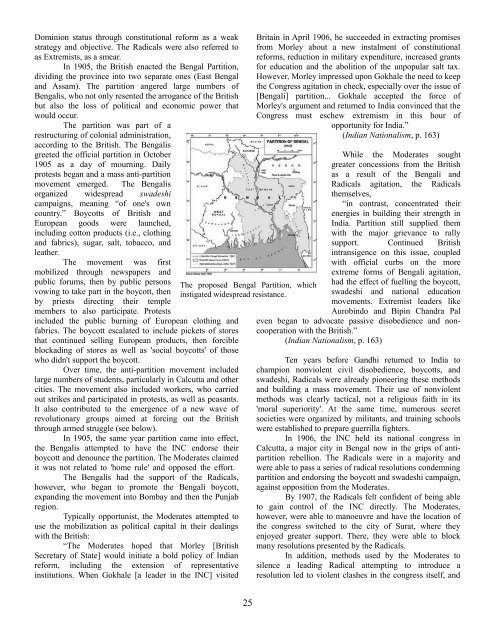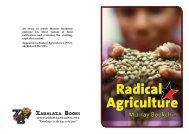smash-pacifism-zine
smash-pacifism-zine
smash-pacifism-zine
You also want an ePaper? Increase the reach of your titles
YUMPU automatically turns print PDFs into web optimized ePapers that Google loves.
Dominion status through constitutional reform as a weak<br />
strategy and objective. The Radicals were also referred to<br />
as Extremists, as a smear.<br />
In 1905, the British enacted the Bengal Partition,<br />
dividing the province into two separate ones (East Bengal<br />
and Assam). The partition angered large numbers of<br />
Bengalis, who not only resented the arrogance of the British<br />
but also the loss of political and economic power that<br />
would occur.<br />
The partition was part of a<br />
restructuring of colonial administration,<br />
according to the British. The Bengalis<br />
greeted the official partition in October<br />
1905 as a day of mourning. Daily<br />
protests began and a mass anti-partition<br />
movement emerged. The Bengalis<br />
organized widespread swadeshi<br />
campaigns, meaning “of one's own<br />
country.” Boycotts of British and<br />
European goods were launched,<br />
including cotton products (i.e., clothing<br />
and fabrics), sugar, salt, tobacco, and<br />
leather.<br />
The movement was first<br />
mobilized through newspapers and<br />
public forums, then by public persons<br />
vowing to take part in the boycott, then<br />
by priests directing their temple<br />
members to also participate. Protests<br />
included the public burning of European clothing and<br />
fabrics. The boycott escalated to include pickets of stores<br />
that continued selling European products, then forcible<br />
blockading of stores as well as 'social boycotts' of those<br />
who didn't support the boycott.<br />
Over time, the anti-partition movement included<br />
large numbers of students, particularly in Calcutta and other<br />
cities. The movement also included workers, who carried<br />
out strikes and participated in protests, as well as peasants.<br />
It also contributed to the emergence of a new wave of<br />
revolutionary groups aimed at forcing out the British<br />
through armed struggle (see below).<br />
In 1905, the same year partition came into effect,<br />
the Bengalis attempted to have the INC endorse their<br />
boycott and denounce the partition. The Moderates claimed<br />
it was not related to 'home rule' and opposed the effort.<br />
The Bengalis had the support of the Radicals,<br />
however, who began to promote the Bengali boycott,<br />
expanding the movement into Bombay and then the Punjab<br />
region.<br />
Typically opportunist, the Moderates attempted to<br />
use the mobilization as political capital in their dealings<br />
with the British:<br />
“The Moderates hoped that Morley [British<br />
Secretary of State] would initiate a bold policy of Indian<br />
reform, including the extension of representative<br />
institutions. When Gokhale [a leader in the INC] visited<br />
The proposed Bengal Partition, which<br />
instigated widespread resistance.<br />
Britain in April 1906, he succeeded in extracting promises<br />
from Morley about a new instalment of constitutional<br />
reforms, reduction in military expenditure, increased grants<br />
for education and the abolition of the unpopular salt tax.<br />
However, Morley impressed upon Gokhale the need to keep<br />
the Congress agitation in check, especially over the issue of<br />
[Bengali] partition... Gokhale accepted the force of<br />
Morley's argument and returned to India convinced that the<br />
Congress must eschew extremism in this hour of<br />
opportunity for India.”<br />
(Indian Nationalism, p. 163)<br />
While the Moderates sought<br />
greater concessions from the British<br />
as a result of the Bengali and<br />
Radicals agitation, the Radicals<br />
themselves,<br />
“in contrast, concentrated their<br />
energies in building their strength in<br />
India. Partition still supplied them<br />
with the major grievance to rally<br />
support. Continued British<br />
intransigence on this issue, coupled<br />
with official curbs on the more<br />
extreme forms of Bengali agitation,<br />
had the effect of fuelling the boycott,<br />
swadeshi and national education<br />
movements. Extremist leaders like<br />
Aurobindo and Bipin Chandra Pal<br />
even began to advocate passive disobedience and noncooperation<br />
with the British.”<br />
(Indian Nationalism, p. 163)<br />
Ten years before Gandhi returned to India to<br />
champion nonviolent civil disobedience, boycotts, and<br />
swadeshi, Radicals were already pioneering these methods<br />
and building a mass movement. Their use of nonviolent<br />
methods was clearly tactical, not a religious faith in its<br />
'moral superiority'. At the same time, numerous secret<br />
societies were organized by militants, and training schools<br />
were established to prepare guerrilla fighters.<br />
In 1906, the INC held its national congress in<br />
Calcutta, a major city in Bengal now in the grips of antipartition<br />
rebellion. The Radicals were in a majority and<br />
were able to pass a series of radical resolutions condemning<br />
partition and endorsing the boycott and swadeshi campaign,<br />
against opposition from the Moderates.<br />
By 1907, the Radicals felt confident of being able<br />
to gain control of the INC directly. The Moderates,<br />
however, were able to manoeuvre and have the location of<br />
the congress switched to the city of Surat, where they<br />
enjoyed greater support. There, they were able to block<br />
many resolutions presented by the Radicals.<br />
In addition, methods used by the Moderates to<br />
silence a leading Radical attempting to introduce a<br />
resolution led to violent clashes in the congress itself, and<br />
25



